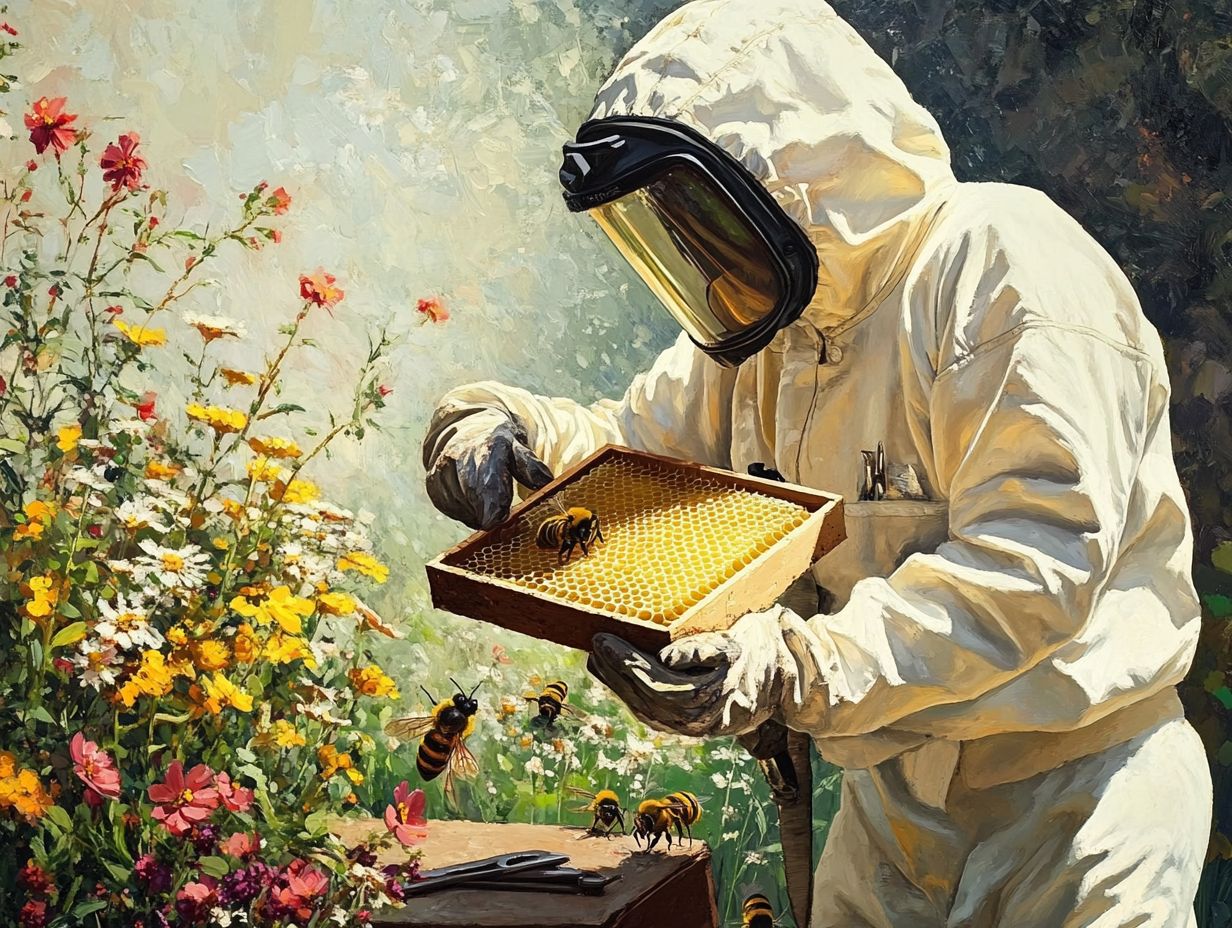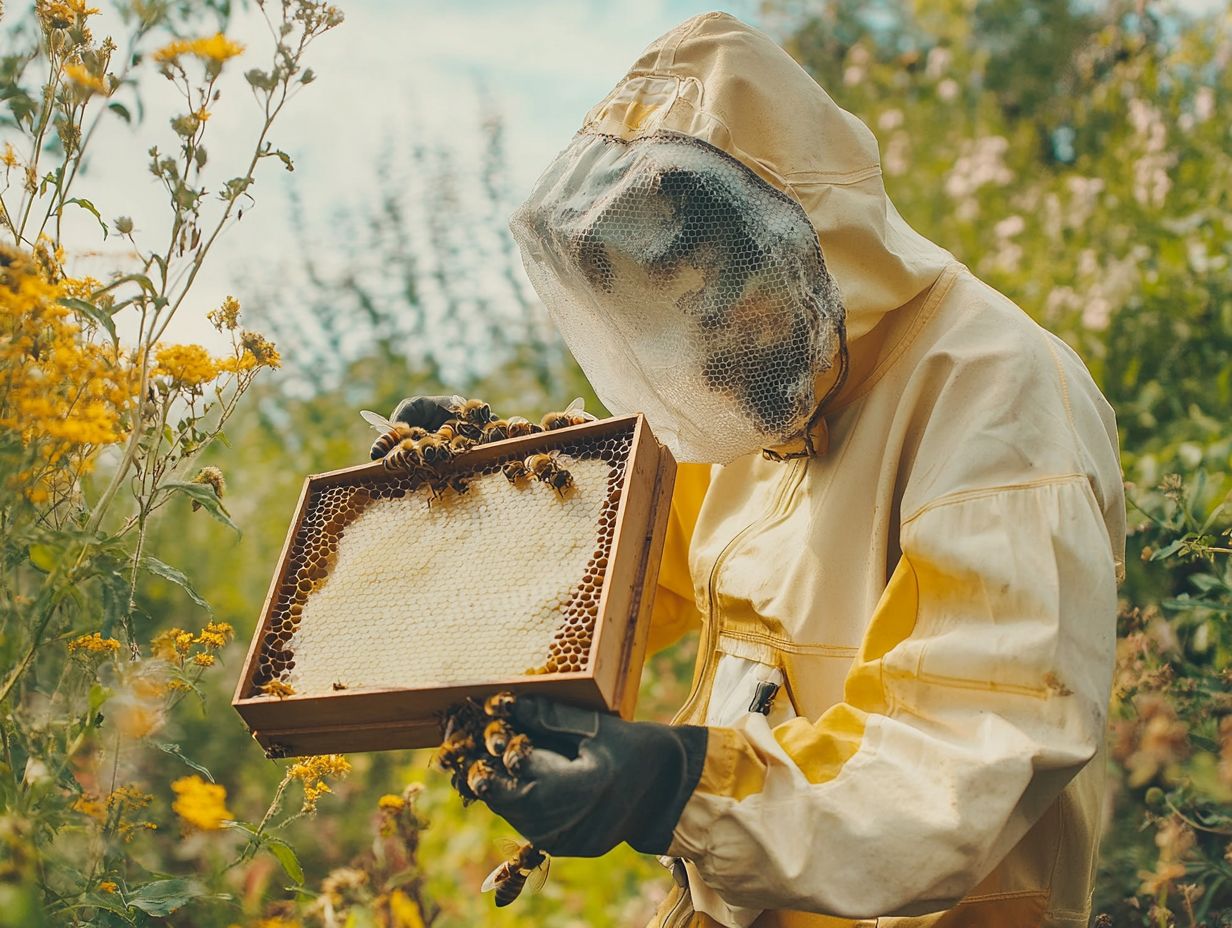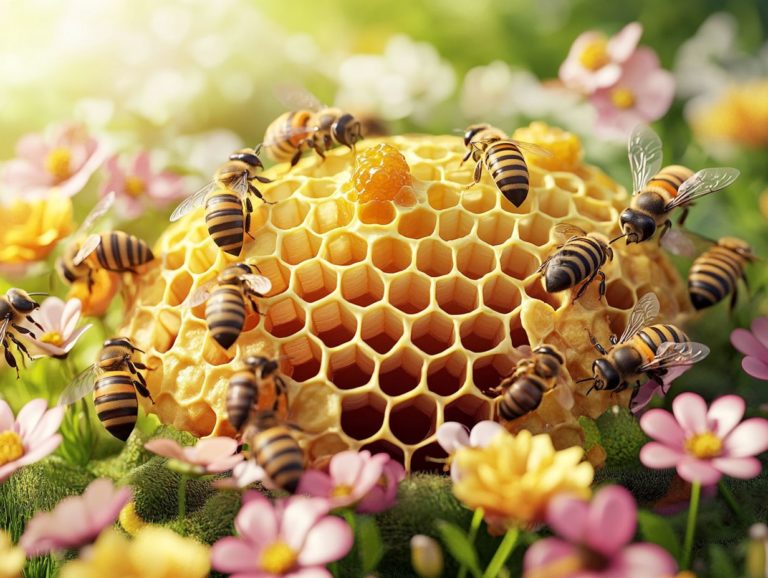Strategies for Managing Weak Hives
Weak hives pose a considerable challenge for beekeepers, often arising from a range of environmental, management, or health-related issues. Understanding the root causes of these vulnerabilities is crucial for effective hive management. This knowledge helps in keeping bees healthy!
This article delves into how you can identify weak hives and recognize their signs and symptoms. It also outlines best practices to prevent their decline and strategies for strengthening weak hives, managing potential risks, and monitoring progress. By doing so, you can ensure your bee colonies thrive and contribute to a healthy ecosystem during the nectar flow.
Contents
Key Takeaways:

- Proper hive management practices can prevent weak hives.
- Feeding and requeening strategies can help strengthen weak hives.
- Regular monitoring and evaluation is crucial for managing weak hives effectively, including using hive assessments and cattle ear tags to track hive health.
What Are Weak Hives?
Weak hives are colonies that show weaker colonies, often grappling to sustain a robust bee population and productivity. This struggle complicates hive management and heightens their susceptibility to diseases such as American foulbrood, a serious bacterial disease that affects honeybee larvae, and other infections.
As a beekeeper in Massachusetts, you face the essential responsibility of recognizing and addressing the signs of weak hives. By doing so, you can prevent further decline and foster a thriving apiary, even during the difficult winter months!
What Causes Weak Hives?
Weak hives can emerge from a variety of causes, including poor nutrition, diseases like American foulbrood, insufficient overwintering conditions for nucleus colonies, and subpar feeding practices. For instance, relying on sugar syrup in a climate-controlled trailer during harsh seasons can lead to problems. Improper use of double deep colonies or single brood box configurations can further worsen these issues.
Each of these factors is crucial to the overall health of your bee colonies. When bees lack proper nutrition, they may become weak and struggle to fend off diseases. This ultimately hinders their ability to thrive during the flowering season.
Inadequate disease management, especially concerning aggressive pathogens like American foulbrood, can devastate entire hives if not addressed promptly. Insufficient care during winter for nucleus colonies leads to high mortality rates, impacting future productivity directly.
By understanding how climate influences feeding practices, you can ensure your bees thrive all year long! This allows them to maintain their strength and resilience against environmental stresses.
All these elements form the backbone of successful beekeeping, underscoring the necessity for vigilance and proactive management in your practice.
How to Identify Weak Hives?
Identifying weak hives is an essential element of effective hive management. It involves conducting regular assessments to monitor colony strength and brood production.
As a beekeeper, you need to be vigilant, looking for specific indicators that set strong colonies apart from their weaker counterparts.
What Are the Signs of a Weak Hive?
You may notice the signs of a weak hive through various observable symptoms. A lack of larvae, poor comb quality, reduced brood production, and an overall decline in bee activity are all indicators of compromised colony strength and health. These warning signs may necessitate immediate action, such as requeening the hive or using treatment methods for American foulbrood. Act quickly to requeen if you notice these signs!
Paying attention to these warning signs can help you assess the vitality of your hive and take necessary actions to restore its balance.
What Are the Symptoms of a Weak Hive?
Symptoms of a weak hive often include a noticeable decline in bee presence and sluggish brood development. Diseases like American foulbrood may also emerge.
As a beekeeper, conducting regular hive assessments is essential. These evaluations help you detect subtle changes in bee behavior and hive dynamics before they escalate into significant problems.
For example, while it’s normal for bee populations to fluctuate with the seasons, a persistent decrease or an inability to build up brood could signal a deeper issue that needs your attention.
It’s equally important to keep an eye out for unusual indicators, such as a lack of foraging activity or erratic honey production patterns. These signs could signal trouble ahead! Act fast to protect your hive.
By spotting these symptoms early, you can intervene swiftly, ensuring that your hives remain strong and productive, especially during critical periods like spring and nectar flow.
How to Prevent Weak Hives?

To prevent weak hives, you must engage in proactive hive management practices. This includes providing adequate nutrition by feeding sugar syrup and pollen substitutes, maintaining strong colonies, and conducting regular assessments to identify potential issues before they escalate.
Understanding nectar and dandelions as natural food sources is helpful. By taking these steps, you can ensure the health and vitality of your beekeeping endeavors.
What Are the Best Practices for Hive Management?
To excel in hive management, adopt a comprehensive approach that blends regular hive assessments and strategic feeding with sugar syrup. This helps maintain strong colonies year-round.
Begin by scheduling consistent inspections to monitor queen health, brood patterns, and overall hive activity. It’s crucial to assess environmental factors, as these significantly influence how your colonies adapt to seasonal changes.
As summer unfolds, for instance, you may find additional food sources necessary. Prompt interventions can help avert the risk of colony starvation.
By skillfully adapting your management techniques to accommodate seasonal shifts, you can greatly enhance both honey production and the overall strength of your hives.
Staying attuned to the hive’s condition and environmental signals allows you to make informed decisions, fostering thriving bee populations and a successful apiary.
What Are the Common Mistakes in Hive Management?
Common mistakes in hive management can lead to the creation of weak hives, such as improper feeding practices, neglecting regular assessments, and failing to recognize early signs of disease or stress in your colonies.
For instance, not splitting colonies when necessary or overlooking the importance of climate-controlled environments during winter can severely impact colony health.
When these errors occur, the overall vitality of your colonies can diminish significantly, leaving them vulnerable to pests and environmental shifts.
Inadequate feeding may weaken a colony’s ability to weather periods of scarcity, while infrequent inspections can allow disease to proliferate unchecked.
You can enhance your beekeeping practices by establishing a routine for hive inspections and maintaining meticulous records of your hives conditions.
By honing your ability to identify signs of distress early on, you can ensure that your bees have access to sufficient food supplies and maintain a clean hive environment with proper honey extraction techniques.
This dramatically improves their resilience and productivity.
How to Strengthen Weak Hives?
Strengthening weak hives is essential for maintaining a thriving apiary. You can achieve this through several effective methods.
Consider re-queening those weaker colonies to reinvigorate their productivity. Generously feeding them with sugar syrup can also provide the necessary nourishment they need.
Don t overlook the option of splitting colonies; this can significantly enhance the overall vitality of your hive population.
Using expert tips can help boost the strength of your hives.
What Are the Best Feeding Practices for Weak Hives?
The best feeding practices for weak hives require a keen understanding of the food needs of your bees during critical periods. Utilizing sugar syrup and pollen substitutes becomes essential to effectively support brood production and overall hive health.
It s particularly important to evaluate hive conditions during early spring or late fall, as natural foraging opportunities are limited at these times. When feeding weak hives with sugar syrup, mix one part sugar with one part water to create an easily digestible solution. Administer this mixture in shallow feeders to prevent any drowning incidents. You can use a climate-controlled trailer to manage feeding during harsh weather.
Incorporating pollen substitutes stimulates brood rearing, especially when genuine pollen sources are scarce. Monitor hive responsiveness by observing the activity levels at the entrance and assessing the frames for brood development after feeding. If you notice the bees becoming visibly active and starting to expand their brood pattern, it s a strong indication that your feeding strategy is working. This underscores the importance of your continued care during these pivotal times.
How to Requeen a Weak Hive?
Requeening a weak hive is an essential process that can breathe new life into a struggling colony. It involves the careful selection of a robust queen and effective management strategies to prevent complications, such as American foulbrood, a serious disease that can affect bees, during the transition.
Timing is crucial; aim to requeen in late spring or early summer when the colony is most active. Selecting a new queen involves evaluating critical traits like disease resistance, productivity, and temperament. These factors greatly influence the hive’s performance. Requeening effectively boosts nectar collection and honey production.
Once you’ve introduced the new queen, closely monitor for any signs of aggression from the existing bees to ensure smooth integration. By providing sufficient food resources and maintaining optimal hive conditions, such as using pollen substitutes and sugar syrup, you ll help the colony regain its strength, maximizing the likelihood of a successful requeening.
What Are the Benefits of Combining Weak Hives?

Combining weak hives can provide a range of benefits, such as strengthening your overall colony, boosting brood production, and allowing for a more efficient use of resources in hive management.
This strategy is particularly effective when you notice struggling colonies that lack the numbers to thrive on their own. By merging these weaker hives, perhaps those using single brood box setups, you create a combined workforce that can enhance foraging efforts, resulting in improved nectar and pollen collection. Uniting these colonies also helps stabilize the hive’s temperature and humidity, creating a favorable environment for rearing brood.
This approach not only maximizes the potential of both hives but also encourages greater genetic diversity within your bee population, which enhances resilience against diseases and environmental shifts.
What Are the Potential Risks of Managing Weak Hives?
Managing weak hives can pose significant risks that may negatively impact your entire apiary. These risks include the potential spread of diseases like American foulbrood, a decline in the overall bee population, and challenges in maintaining effective hive management practices.
Act now to tackle these issues for a healthier hive! Implementing treatment methods and regular hive assessments are essential steps.
How to Identify and Treat Diseases in Weak Hives?
Identifying and treating diseases in weak hives is essential for preventing further deterioration. You can achieve this through regular hive assessments to spot symptoms of illness, such as American foulbrood, and by implementing effective treatment methods.
Early recognition of signs like reduced brood patterns, abnormal coloration, or unusual odors can significantly impact the health of your hive. As a beekeeper, it s crucial to remain vigilant in monitoring for other common ailments, including Varroa mite infestations, which are harmful parasites, and Nosema disease, both of which can severely weaken your colony.
Employing techniques like sticky boards to track mite levels or sugar shakes to detect Nosema can provide you with valuable insights into the health of your hive. Treatment might involve chemical interventions or strategic management techniques, all aimed at maintaining a balanced ecosystem within the hive.
This could also include using pollen substitutes during periods of low nectar flow.
By emphasizing prompt action, you not only support recovery but also enhance overall hive productivity and resilience against future threats.
What Are the Effects of Pesticides on Weak Hives?
The effects of pesticides on weak hives can be quite detrimental, potentially increasing mortality rates, diminishing colony strength, and heightening susceptibility to diseases such as American foulbrood. This can complicate your hive management efforts.
These chemicals disrupt the natural behaviors of bees, impairing their foraging abilities and hampering effective communication within the colony. This disturbance can create a vicious cycle; as weakened bees struggle to gather food, nutritional deficiencies emerge, further compromising their health.
Pesticide exposure can also decrease reproductive success, which is crucial for maintaining colony numbers. Act now! Explore organic farming practices, integrate pest management strategies, and utilize plant-based repellents to protect these vulnerable populations from harmful substances like cattle ear tags that might attract pests.
By prioritizing bee-friendly practices, you can achieve a more sustainable approach to agriculture, fostering healthier hives and contributing to stronger ecosystems. Considerations such as overwintering nucs and using a climate controlled trailer for transportation can be beneficial.
How to Monitor and Evaluate the Progress of Weak Hives?
To effectively monitor and evaluate the progress of weak hives, you need to conduct consistent hive assessments that delve into key indicators. Focus on aspects such as colony strength, brood production, and how well you feed your bees, including the strategic use of sugar syrup.
This meticulous approach will enable you to identify areas for improvement and foster the health of your hives.
What Are the Key Metrics to Track in Weak Hives?
The key metrics you should track in weak hives encompass colony strength, brood production rates, and the overall health of the bee population. Each of these elements is vital for effective hive assessments and management strategies.
Monitoring these specific metrics offers invaluable insights into the vitality and productivity of your hive. For instance, by assessing colony strength, you can gauge the number of bees available for foraging and brood rearing. Analyzing brood production rates can reveal the queen’s health and the hive s potential for growth.
Understanding the overall health of the bee population involves keen observation for signs of disease or pest infestations. By regularly analyzing these indicators, you ll empower yourself to make smart management decisions that strengthen your hives!
Keeping detailed records over time not only helps you recognize trends but also gives you the power to make informed adjustments that enhance hive resilience.
What steps will you take today to ensure the health of your hives?
How to Adjust Management Strategies Based on Hive Strength?

Adjusting your management strategies based on hive strength is essential for you as a beekeeper. This approach allows you to tailor your feeding practices, such as the use of sugar syrup, along with other interventions to effectively support both weak and strong colonies.
Recognizing the condition of your bees is crucial. A strong colony will require different care like regular hive inspections and monitoring for pests compared to a weakened one, which might benefit from nutritional supplements or extra warmth during colder months. For instance, a thriving colony can be encouraged to expand by adding new honey supers or using a queen excluder, while a struggling hive may need you to reduce space and consolidate resources to alleviate stress.
This flexibility in hive management not only promotes healthier bees but also enhances your overall productivity, ensuring that each colony receives the precise care that aligns with its specific needs. This tailored approach can help in better honey extraction processes and efficient management of double deep colonies.
Frequently Asked Questions
What are some common strategies for managing weak hives?
Some common strategies for managing weak hives include providing additional food sources, using medication or treatments, and introducing new, healthy bees to the hive from other split colonies or using larvae from a strong colony.
How can I prevent my hive from becoming weak?
To prevent a hive from becoming weak, make sure to regularly inspect and maintain the hive, provide proper nutrition, and monitor for pests and diseases.
What should I do if my hive is already weak?
If your hive is already weak, try to pinpoint the cause of the weakness and address it promptly. This may include providing supplemental food like sugar syrup, treating for pests or diseases, or re-queening the hive.
Is it possible to revive a weak hive?
In some cases, it is possible to revive a weak hive by implementing the appropriate strategies and treatments. However, it is important to assess the health and strength of the hive before trying to revive it.
How can I introduce new bees to a weak hive?
To introduce new bees to a weak hive, it is important to slowly and carefully integrate them into the existing hive to avoid any conflicts or stress. This can be done by using a queen introduction cage or gradually adding frames of bees from another hive.
Should I cull a weak hive?
Culling a weak hive should be a last resort option. Before making the decision to cull a hive, it is important to consult with a beekeeping expert and exhaust all possible strategies for managing and reviving the hive. Industry experts such as Steritech Pty Ltd in Australia could provide valuable insights.






